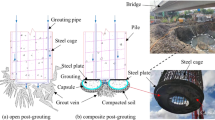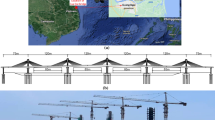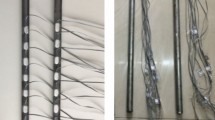Abstract
The excavation method has significant effects on the response of piles, and post-grouting is a great way to improve the response of piles. In this research, field static load tests were performed on three large-diameter and superlong rock-socketed bored piles (LSRBPs) of superhigh-rise constructions. The effects of composite excavation and combined grouting on the response of LSRBPs were studied. The improved effects of combined grouting on LSRBPs that were drilled by composite excavation were discussed. The results indicate that the composite excavation improves construction efficiency but affects shaft-forming quality, thus lowering the bearing capacity of LSRBPs, while combined grouting can contain this defect. Despite reducing the original pile size, combined grouting still significantly improves the bearing capacity of LSRBS and reduces the dispersion of bearing capacity. Existing pile design methods overestimate the bearing capacity of LSRBPs constructed using composite excavation, but underestimate it after combined grouting. The composite excavation forms different pile-rock (soil) interfaces, which affects the effectiveness of combined grouting. The simultaneous application of composite excavation and combined grouting reduces design pile size and improves construction efficiency, thereby achieving the goals of cost reduction and low-carbon construction. The findings have significant implications for the construction and design of LSRBPs.


















Similar content being viewed by others
Data availability
Raw data were generated at the large-scale pile test. Derived data supporting the findings of this study are available from the corresponding author upon request.
References
American Association of State Highway and Transportation Officials (2012) Standard specifications for highway bridges, 6th edn. United States, Washington DC
Armaghani D, Shoib R, Faizi K, Rashid A (2017) Developing a hybrid PSO–ANN model for estimating the ultimate bearing capacity of rock-socketed piles. Neural Comput Appl 28(2):391–405. https://doi.org/10.1007/s00521-015-2072-z
Bruce D (1986) Enhancing the performance of large diameter piles by grouting. Groun Eng 19(5):11–15. https://doi.org/10.1016/0148-9062(87)91441-0
Dapp S, Brown D (2010) Evaluation of base grouted drilled shafts at the Audubon bridge. In: Geo Florida 2010: advances in analysis, modeling and design. Florida, USA, pp 1553–1562
Dou L, Li H (2017) Analysis of the key and difficult points in the engineering construction technology of the steel structures of a super high-rise building. In: IOP conference series: materials science and engineering. Xian, pp 1–4
Fleming W (1993) The improvement of pile performance by base grouting. P I Civil Eng-Civ En 97(2):88–93. https://doi.org/10.1680/icien.1993.23262
Federal Highway Administration Office of Bridges and Structures (2017) Evaluation and guidance development for post-grouted drilled shafts for highways. United States, Washington DC
Feng SJ, Lu SF, Shi ZM (2016) Field investigations of two super-long steel pipe piles in offshore areas. Mar Georesour Geotec 34(6):559–570. https://doi.org/10.1080/1064119X.2015.1038760
Hai NM, Fellenius BH (2014) O-cell tests on two 70 m long bored piles in Vietnam. In: From soil behavior fundamentals to innovations in geotechnical engineering. Atlanta, pp 482–496
Hu Q, Zeng J, He L, Fu Y, Cai Q (2021) Effects of displacement-softening behavior of concrete-mudstone interface on load transfer of belled bored pile. Arab J Geosci 14(23):1–12. https://doi.org/10.1007/s12517-021-08523-z
Huang X, Mei Y, Wang RY, Li T, Lei B, Zhao W (2020) An analysis on comparison of the static load test performed to post-grouted pile foundation with Chinese, American and European standard. Tehnicki Vjesnik 27(3):978–985
Klinkvort RT, Hededal O, Springman SM (2013) Scaling issues in centrifuge modelling of monopiles. Int J Phys Model Geo 13(2):38–49. https://doi.org/10.1680/ijpmg.12.00010
Li SC, Zhang Q, Zhang QQ, Li LP (2016) Field and theoretical study on the response of super-long bored pile subjected to compressive load. Mar Georesour Geotech 34(1):71–78. https://doi.org/10.1080/1064119X.2014.958883
Li XJ, Dai GL, Zhu MX, Gong WM (2019) Application of static loading tests to steel pipe piles with large diameters in chinese offshore wind farms. Ocean Eng 186:106041. https://doi.org/10.1016/j.oceaneng.2019.05.023
Lee JS, Park YH (2008) Equivalent pile load-head settlement curve using a bi-directional pile load test. Comput Geotech 35(2):124–133. https://doi.org/10.1016/j.compgeo.2007.06.008
Liu KF, Xie XY, Luo Z, Hu QH, Huang CX (2017) Full-scale field load testing of long drilled shafts with enlarged base constructed in marine sediment. Mar Georesour Geotec 35(3):346–356. https://doi.org/10.1080/1064119X.2016.1172684
Liu NW, Zhang ZM, Zhang QQ, Fang K (2013) Destructive field tests on mobilization of end resistance of cast-in-situ bored piles. J Cent South Univ 20(4):1071–1078. https://doi.org/10.1007/s11771-013-1586-8
Ministry of Housing and Urban-Rural Development of the People's Republic of China (2017) Technical specification for static loading test of self-balanced method of building foundation piles. Beijing
Momeni E, Nazir R, Armaghani DJ, Maizir H (2014) Prediction of pile bearing capacity using a hybrid genetic algorithm-based ANN. Meas 57:122–131. https://doi.org/10.1016/j.measurement.2014.08.007
Mullins G (2016) Construction qa/qc methods for postgrouting drilled shafts. J Perform Constr Fac 30(4):04015085. https://doi.org/10.1061/(asce)cf.1943-5509.0000827
Mullins G, Winters D, Dapp S (2006) Predicting end bearing capacity of post-grouted drilled shaft in cohesionless soils. J Geotech Geoenviron 132(4):478–487. https://doi.org/10.1061/(asce)1090-0241(2006)132:4(478)
Nguyen MH, Fellenius BH (2015) Bidirectional cell tests on non-grouted and grouted large-diameter bored piles. J Geo-Eng Sci 2(3):105–117. https://doi.org/10.3233/jgs-140025
Osterberg J (1989) New device for load testing driven piles and drilled shafts separates friction and end bearing. In: Proceedings of the international conference on piling and deep foundations. London, pp 421–427
O’Neill MW, Reese LC (1999) Drilled shafts: construction procedures and design methods. United States, Washington DC
O’Neill MW (2001) Side resistance in piles and drilled shafts. J Geotech Geoenviron 127(1):1–16. https://doi.org/10.1061/(ASCE)1090-0241(2001)127:1(3)
Ozgurel HG, Vipulanandan C (2005) Effect of grain size and distribution on permeability and mechanical behavior of acrylamide grouted sand. J Geotech Geoenviron 131(12):1457–1465. https://doi.org/10.1061/(asce)1090-0241(2005)131:12(1457)
Ruiz ME (2005) Study of axially loaded post grouted drilled shafts using CPT based load transfer curves. Dissertation, University of Puerto Rico
Shi B, Zhang Y, Zhang W (2019) Run-out of the 2015 shenzhen landslide using the material point method with the softening model. B Eng Geol Environ 78(2):1225–1236. https://doi.org/10.1007/s10064-017-1167-4
Sliwinski ZJ, Fleming W (1984) The integrity and performance of bored piles. England, London, pp 211–223
The Professional Standards Compilation Group of People’s Republic of China (2008) Technical code for building pile foundations. Beijing
Thiyyakkandi S, Mcvay M, Bloomquist D, Lai P (2014) Experimental study, numerical modeling of and axial prediction approach to base grouted drilled shafts in cohesionless soils. Acta Geotech 9(3):439–454. https://doi.org/10.1007/s11440-013-0246-3
Thiyyakkandi S, Mcvay M, Lai P, Herrera R (2017) Suitability of jetted and grouted precast pile for supporting mast arm structures. Can Geotech J 54(9):1231–1244. https://doi.org/10.1139/cgj-2016-0467
Wan ZH, Dai GL, Gong WM (2018) Full-scale load testing of two large-diameter drilled shafts in coral-reef limestone formations. B Eng Geol Environ 77(3):1127–1143. https://doi.org/10.1007/s10064-017-1206-1
Wan ZH, Dai GL, Gong WM (2019) Field study on post-grouting effects of cast-in-place bored piles in extra-thick fine sand layer. Acta Geotech 14(5):1357–1377. https://doi.org/10.1007/s11440-018-0741-7
Wan ZH, Dai GL, Gong WM (2020) Field and theoretical analysis of the response of axially loaded grouted drilled shafts in extra-thick fine sand. Can Geo J 57(3):391–407. https://doi.org/10.1139/cgj-2018-0382
Wang Q, Shi ZY, Zhang C, Wen XK (2013) Application study of self-balanced testing method on big diameter rock-socketed piles. J Eng Sci Tech 6(2):168–172
Wei Q, Yang XD, Jiang SL (2013) Analysis of the results of pile trial for the subsidiary high-rise building of the shandong provincial center for culture and art. Appl Mech Mater 353:1090–1096. https://doi.org/10.4028/www.scientific.net/AMM.353-356.1090
Xing H, Liu L, Luo Y (2019) Effects of construction technology on bearing behaviors of rock-socketed bored piles as bridge foundations. Int J Bridge Eng 24(4):05019002. https://doi.org/10.1061/(asce)be.1943-5592.0001368
Yoon J, Mohtar C (2014) Groutability of granular soils using bentonite grout based on filtration model. Transport Porous Med 102(3):365–385. https://doi.org/10.1007/s11242-014-0279-6
Zhang Q, Zhang Z (2012) Complete load transfer behavior of base-grouted bored piles. J Cent South Univ 19(7):2037–2046. https://doi.org/10.1007/s11771-012-1242-8
Zhang WL, Yuan ZJ, Li DQ, Liao YS, Zhao LY (2021) Application potentials of decomposed granite from benggang area in south china as fine aggregates in cement-based materials. Constr Build Mater 310(9):125109. https://doi.org/10.1016/j.conbuildmat.2021.125109
Zhang Z, Gong WM, Dai GL, Xu J (2021) Enhancement of load bearing of post-grouted drilled shafts based on in situ tests. Arab J Geosci 14(32):1–13. https://doi.org/10.1007/s12517-020-06332-4
Zhou ZJ, Xu F, Lei JT, Bai Y, Chen CR, Xu TY, Zhang ZP, Zhu LX, Liu T (2021) Experimental study of the influence of different hole-forming methods on the bearing characteristics of post-grouting pile in loess areas. Trans Geotech 27:100423. https://doi.org/10.1016/j.trgeo.2020.100423
Acknowledgements
The authors are very grateful to the reviewers for their helpful comments and constructive suggestions in improving this paper.
Funding
This work was supported by the National Natural Science Foundation of China (52008100, 51878160, 52078128), and Natural Science Foundation of Jiangsu Province (BK20200400).
Author contribution’s
Conceptualization was contributed by TH; methodology was contributed by TH; formal analysis and investigation were contributed by BF, TH; writing—original draft preparation, was contributed by TH; writing—review and editing, was contributed by BF; funding acquisition was contributed by GD; resources was contributed by Wg; supervision was contributed by Zw, GD.
Author information
Authors and Affiliations
Corresponding authors
Additional information
Publisher's Note
Springer Nature remains neutral with regard to jurisdictional claims in published maps and institutional affiliations.
Rights and permissions
Springer Nature or its licensor (e.g. a society or other partner) holds exclusive rights to this article under a publishing agreement with the author(s) or other rightsholder(s); author self-archiving of the accepted manuscript version of this article is solely governed by the terms of such publishing agreement and applicable law.
About this article
Cite this article
Hu, T., Dai, G., Wan, Z. et al. Field study of the effects of composite excavation and combined grouting on the response of large-diameter and superlong rock-socketed bored piles. Acta Geotech. 19, 1853–1871 (2024). https://doi.org/10.1007/s11440-023-02021-0
Received:
Accepted:
Published:
Issue Date:
DOI: https://doi.org/10.1007/s11440-023-02021-0




